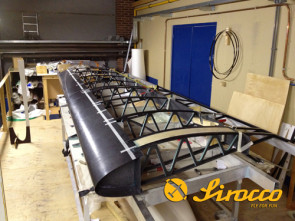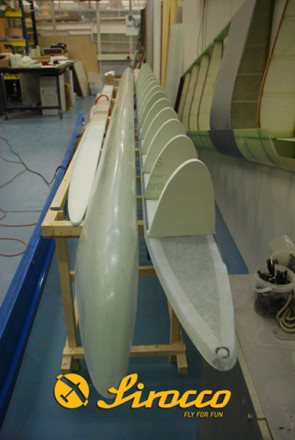Laminated-in carbon strips or rods in glider and ultralight wings or wind turbine blades
The modern plastic wings of gliders or ultralights are assembled to scale. The wing consists of an upper and lower component of the scale. The scale components are often assembled as a sandwich construction: an upper and lower laminate of fibre-reinforced plastics with a light filler in between as core material (e.g. polyurethane foam). Glass or carbon fabrics are most often used as fibres in the laminate and are positioned at an angle of 45° in the skin, so that the closed scale construction offers the wing optimal torsion rigidity.
Locally, at the thickest section of the wing, a number of layers of unidirectional fibres are incorporated longitudinally (in the direction of the wing span). These reinforcements are called purlins and they provide the wing with the necessary bending stiffness. The web plates between the purlins provide spacing between the purlins. The purlins are usually incorporated in the upper and lower scale, or in the web plates. Together, the purlins and the web plates constitute the wing spars which have to minimise the wing deflection. Often, ribs are also incorporated in the wing to provide spacing between the scale components.
In the short film below, a strength test is carried out on a carbon-reinforced wing of an ultralight.
A modern development is the use of pultruded carbon rods or strips as purlin material. The carbon profiles are directly laminated in between the other fibre layers of the skins or web plates. The most important advantage is the very high and reliable quality of the DPP pultrusion profiles. Moreover, it saves a great deal of manufacturing time, as laminating the unidirectional fibres by hand is very labour intensive.
Similarly, carbon-reinforced strips and rods are also applied as reinforcement in wind turbine blades.
« Back


